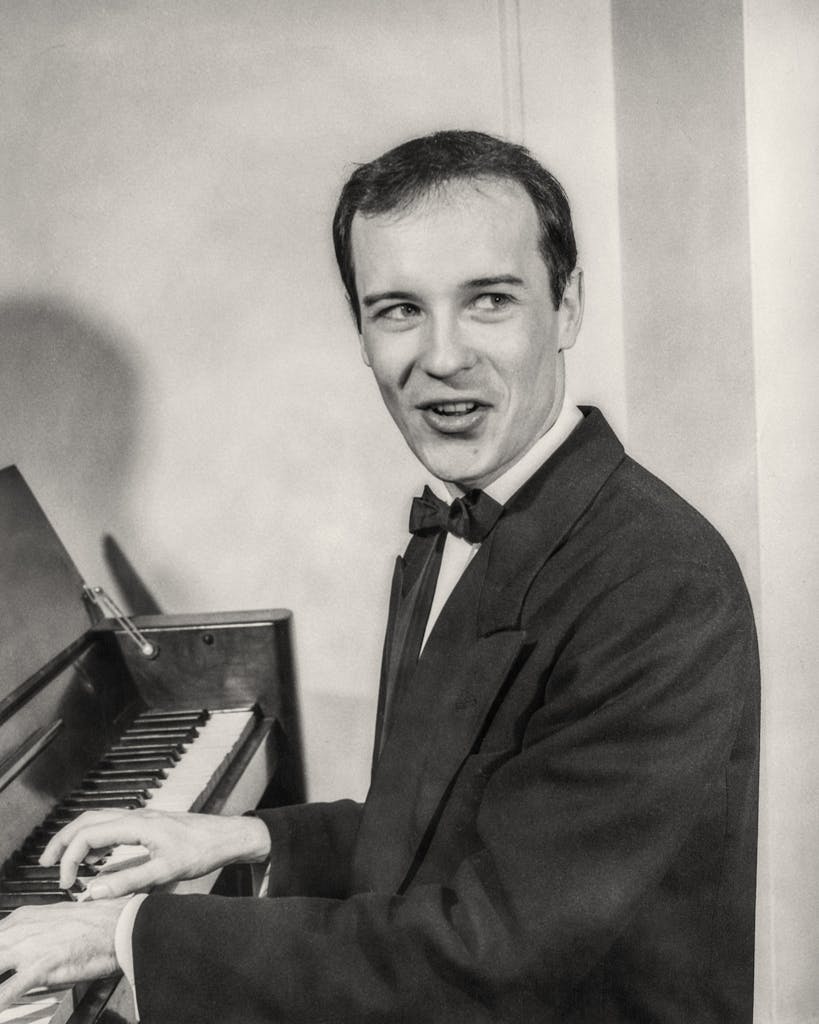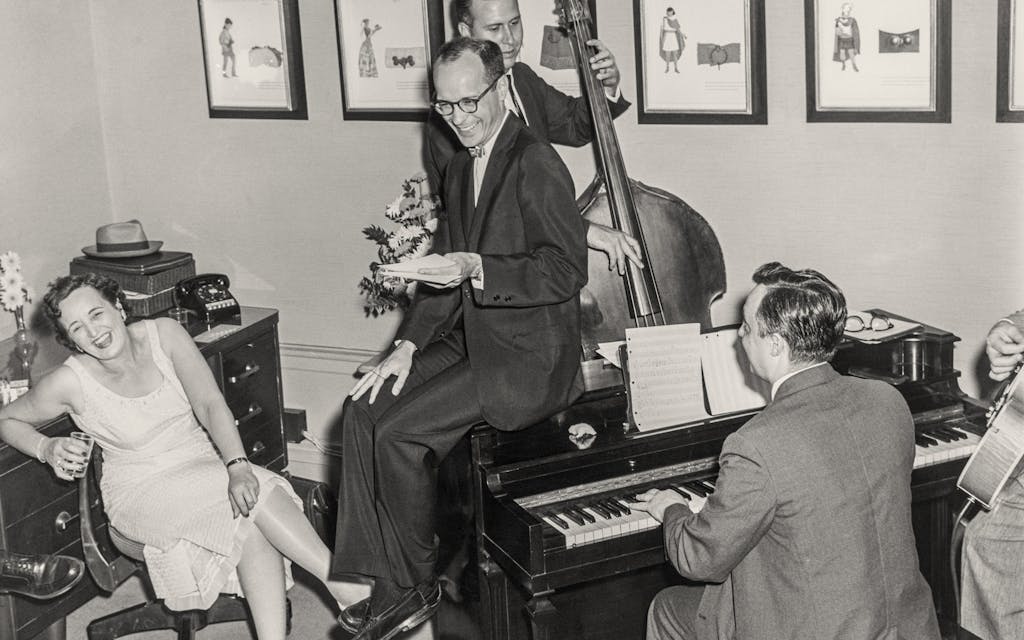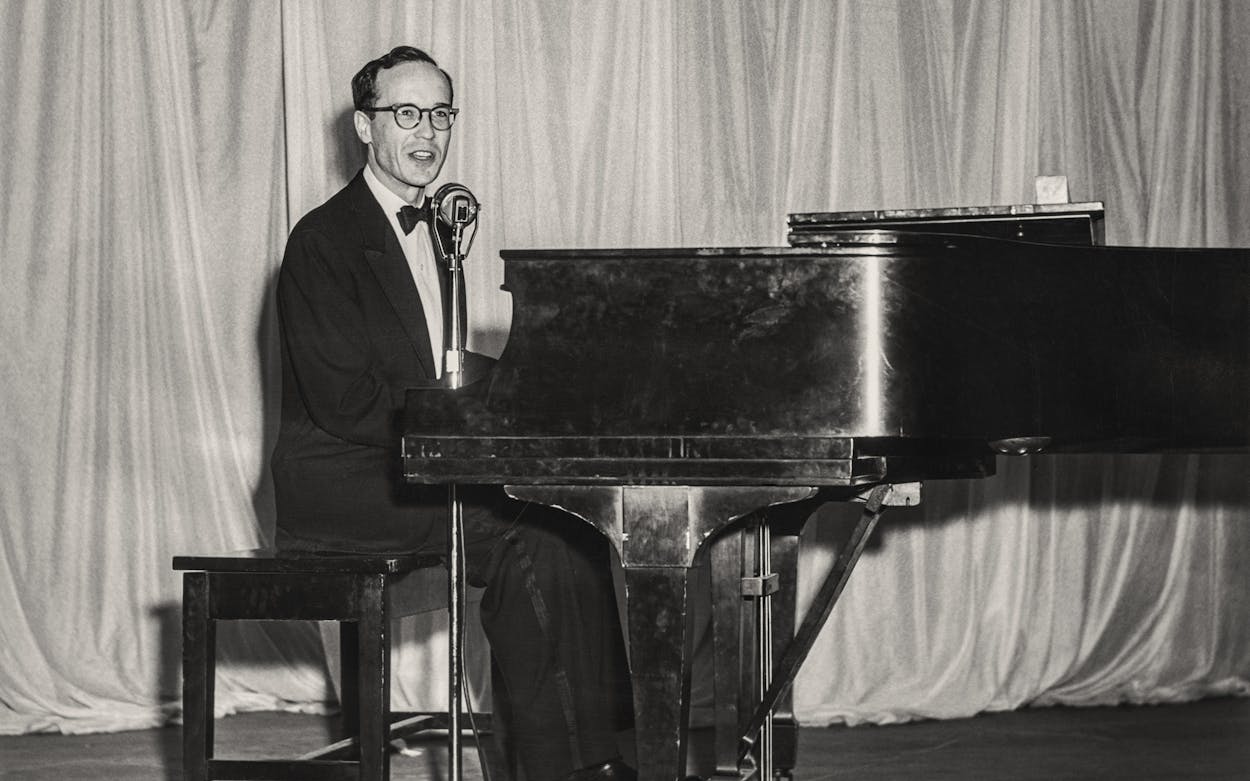A man in a bow tie and an old-fashioned suit walks slowly along a sidewalk, smiling shyly and singing. “Good morning, Kemmerer,” he sings, in full voice. “Good morning!” The tune is dramatic and a little corny, a man singing to a town—Kemmerer, Wyoming, 1902. His hair is short, his mustache full; he carries a broom. He turns and walks back, his hopeful face suddenly turning somber as he stands in front of a window with his name painted on it: J. C. Penney, proprietor. “It is six a.m. and no one’s come,” he sings, as the music resolves sadly to a minor chord. “I’ve swept the sidewalk twenty times this morning. My heart is beating louder than a drum”—he makes a fist with his left hand. “Won’t you come?” The camera pans the empty streets.
The scene, with its mix of melodrama and melody, is reminiscent of old-time Broadway musicals. Opening Day at the Golden Rule was a short film made in 1962 by J.C. Penney dramatizing the first hours in the life of the company (that first Kemmerer store was called the Golden Rule). The song was part of a musical called Penney Proud that was performed at corporate conventions around the country in the early sixties. Penney Proud was made during a thriving period for American business, the fifties and early sixties, when companies hired New York songwriters and producers to create shows for their employees at conventions and sales conferences—to motivate, cheerlead, and entertain. These weren’t just musicals. They were industrial musicals.
Some of them were downright awful, with bumbling productions and cringey songs. But the good ones were fascinating spectacles of showbiz and capitalism; in the best, there was a lot more than met the eye—and ear. Watching the man with the broom, you could see this wasn’t just a history of a department store. It was a story about the American dream, a tale of hope, doubt, and dedication. The song was stirring, stylized, and had a melody that stuck in your head. It was written and performed by one of the most famed creators of industrials, a man named Michael Brown. He was also a singer, pianist, producer, and actor. That’s him with the broom. Playing a nice but determined small-town dreamer came naturally to him.

He was born Marion Martin Brown II, on December 14, 1920, in Mexia (muh-HEY-ah), which sits in the grasslands of Central Texas about fifty miles east of Waco. The baby was named after his father, Mexia’s beloved town doctor and surgeon, who founded Brown Hospital just down the street from their home. Dr. Brown, as everyone called him, was also a civic leader, heading the chamber of commerce and serving on the state board of medical examiners. “Sonny,” as Marion was nicknamed, was only eighteen months old when his mother died and his father remarried.
Sonny was a cheerful, brainy kid, reading at age four and skipping over several grades in school. He was a good-hearted ham and became well-known at the local movie theater for reading out loud the captions in silent films for patrons who were illiterate. Sonny loved music, and his father bought him a piano, which he began playing at age six. He also developed an early fascination with Manhattan—a family friend had a subscription to the New Yorker and the boy would sit for hours, poring over issues. He played drums in the high school marching band and was soon writing grown-up songs, like “If I Were Free”:
If I were free to do what I’d like to do
And had ambition and a lot of vim
I’d go so far away that someday they’d say
“I wonder what happened to him?”
Sonny adored his father and at first felt obligated to follow in his footsteps, graduating from Mexia High School at fifteen and entering the University of Texas in Austin in the fall of 1936. He joined a fraternity and took premed classes but spent much of his time reading novels and playing the piano; he loved jazzy songs like “Walking My Baby Back Home” and thought he could write like that. Finally, he told his father that he wasn’t cut out to be a doctor. Instead, he joined the Curtain Club, a UT theater group.
When he graduated Phi Beta Kappa after four years, he wasn’t sure what he wanted to do. Brown went to three different grad schools, studying drama and literature, and ended up earning a master’s degree from the University of Virginia, where he wrote songs and had a radio program devoted to them. “His piano style is light and engaging in character and humorous in phrasing,” said a story in the student paper. Brown was close enough to New York that he would hop on a train, head to Manhattan, and go to the cabaret club Le Ruban Bleu, where Ella Fitzgerald and Liberace performed, as well as various trios and comedians. Brown informed the owner, Julius Monk, that he wrote songs too; Monk told him to come back and audition when he was done with school.
There was a war going on, and in 1944 Brown was sent to Curacao and Trinidad as a cryptographics officer in the Army Air Forces. When he wasn’t listening to enemy radio chatter, he was writing songs and organizing shows for his fellow troops. Brown loved performing. By the end of the war, he had written two hundred songs and figured it was time to try the big time, so in 1946 he moved to New York. The new start came with a new name: Michael. Marion, he reckoned, sounded too Southern.
Brown worked various temp jobs, including as a typist for Billboard magazine, while honing his piano and singing skills. In 1948 he went back to Le Ruban Bleu and auditioned. He got the gig and did 54 weeks in a row (a record at the club) performing two and sometimes three shows a night—his own songs, cabaret-style, sharing bills with the likes of the Four Lads and comedian Connie Sawyer (“the Clown Princess of Comedy”). Brown got gigs at other hip clubs too, like the elegant Blue Angel, which featured singers like Bobby Short and Eartha Kitt.
Always dressed impeccably, usually in a black coat and bow tie, he fit in with the suave New York crowd—but the small-town kid stood apart from it too. In January 1949, Alice Hughes profiled Brown for the New York World-Telegram. “Sophistication makes people interesting,” she wrote, “maybe exciting, but rarely sweet.” She compared the genial Brown to Noël Coward, writing, “Audiences adore his off-beat piano playing and his songs with subtle four-letter nuances crouched in unexpected phrases. At first they are charmed, then startled, then finally introspective.”
Brown’s songs were literate and catchy, always with a hummable melody. They had a bounce to them, whether he was being satirical or sentimental. “I guess I write about the ways folks feel today,” he told Hughes. “They’re eager but frustrated. They try to go forward but they lurch instead. Some of it is sad some comes out funny.” One of his more popular numbers was “Fall River Hoedown,” a lighthearted look at famed axe murderer Lizzie Borden:
Oh, you can’t chop your mama up in Massachusetts
And then blame all the damage on the mice.
No, you can’t chop your mama up in Massachusetts.
That kind of thing just isn’t very nice
He also penned beautiful love songs like “I Know a Place” and a dozen odes to New York, such as “Hey, Times Square!” Many days he would write a song based on something he read in the newspaper that morning, then play it that night at a club. One of his new fans was a professional ballerina named Joy Williams. “When he came onstage,” she said, “you couldn’t take your eyes off him. There are people in the world who have a presence up there, and Michael had it.” Brown had a sparkling smile to go with his witty banter and pleasant face. He’d arch an eyebrow at a lyric, then smile impishly. Brown looked like the happiest man in the room. He and Joy fell in love and married in 1950.

In the years after World War II, anything seemed possible in America, especially in business. Corporations that were flush with cash began hiring Big Apple songwriters to write and produce numbers for their yearly gatherings, to give selling tips and management advice, but also to create—through song and spectacle—a sense of togetherness and hope among employees. The songs grew into actual shows, some of which (Diesel Dazzle, The Bathrooms Are Coming) were recorded and filmed. Listening today, you can hear and see an enthusiasm for American products that now feels quaint: Lightbulbs! Oldsmobiles! Silicone! While much of it was kitsch—and resembles a Mad Men–like parody of the era—you’ll also hear Broadway melodies, funny lyrics, and evocative stories, like something from Camelot, only sung about Edsels.
“The industrial musical was a rare genre of music that was designed to be hidden from the public,” said Steve Young, coauthor of Everything’s Coming Up Profits: The Golden Age of Industrial Musicals. “It was the last large piece of twentieth century culture that escaped the net of popular or critical notice.” Companies with big budgets paid struggling Broadway writers and singers to write and produce their own shows. Before Sheldon Harnick and Jerry Bock wrote Fiddler on the Roof, they wrote an industrial about tractors called Ford-i-fy Your Future. The companies paid well, and young actors like Florence Henderson, Bob Newhart, and Chita Rivera played along.
Brown made a very good living on industrials. For JC Penney’s fiftieth anniversary in 1952, he wrote the words and music to Penneytown USA, which played in various cities around the country. Founder James Cash Penney led a standing ovation for Brown at the San Francisco performance. Soon Brown was writing his jaunty songs for other department stores too, as well as for Talon Zipper and the Singer Company. (He wrote them on his boyhood piano, which he had shipped from Mexia to New York.) Brown knew his songs were ads, but they were going to be as hummable as the songs he sang at the Blue Angel. And Brown not only wrote, sang, and played piano in the shows, he also directed. This, Young said, was unusual. “All the other songwriters were very good writers, but they were not performers. Michael Brown was such a showman and a performer that it was kind of a natural for him to wear all the hats.”

Brown and Joy bought a brownstone on tony E. Fiftieth Street, where they would raise three sons—Michael, Kelly, and Adam. Brown was becoming so well-known as a Manhattan cabaret performer (in London he was called “the American Noël Coward”) that on July 2 and 3, 1956, he and Jack Parr costarred to fill in for Steve Allen on the Tonight show. In a conformist age, Brown was a sophisticated weirdo with an off-kilter sense of humor. In the liner notes of an album he made in 1962, his bio read: “He weighs three hundred pounds and is exactly four feet tall. For a hobby, he goes in for alligator wrestling, a sport at which he wins most of the time.”
Brown worked for numerous clients (he did some fifty shows in his life), but his biggest was DuPont, for whom he wrote, produced, and directed several shows, including Wonderful World of Chemistry. Most industrials were in-house productions, but this one, which cost an astounding $2.8 million, was shown to the public at the 1964 World’s Fair in New York—48 times a day at two different theaters. Some five million people saw the 24-minute show, making it the most seen musical ever.
Brown eventually branched out from industrials—in 1966 he wrote a children’s book called Santa Mouse that, with its four sequels, sold almost a million copies—and occasionally made inroads to Broadway. But only a few of his songs were performed there, and they were done in other people’s shows. The most famous was “Fall River Hoedown,” which later became a hit for the Chad Mitchell Trio. (Brown’s “John Birch Society”—“You cannot trust your neighbors, or even next of kin / If Mommy is a commie then you gotta turn her in”—was also a hit for the group.)
Unfortunately, when Brown tried in earnest to make it to Broadway, he failed. In 1972 he took a show he had written and produced for Penney’s called Marvelous Times and adapted it for Broadway as Different Times, but it folded after 24 performances and harsh reviews. A few years later, Brown bypassed Broadway altogether for The Great American Nut Show, a one-man production about the oddball characters he’d written about over the years, people such as bank robber John Dillinger. “Misfits really fascinate me,” he said. The Nut Show toured in Arizona, Missouri, and, in November 1975, Mexia. “I finally made it,” he said after the performance. “I graduated from Mexia High School and now I’m back home.”
Brown spent much of the eighties and nineties working on a musical version of the novel Stella Dallas, which had been made into a Barbara Stanwyck movie in 1937. Though he finished the score, he could never find funding to get it produced. He spent his later years hanging around the brownstone with Joy, playing the piano, writing, and reading. “He was the best-read person I ever met,” said his eldest son Michael Jr. “He knew more about the English language than anyone.” When he went out to give talks at the Century Association or to read Santa Mouse to children at the library, he looked like the suave New Yorker he was: short silver hair, a dark turtleneck, and a black blazer.
The Brown family was severely tested in 1994, when the body of the youngest son, Adam, was found in the East River. He had died of a drug overdose. Ten days later, Michael Jr. was scheduled to wed. He remembers that the family discussed postponing, but his father put his foot down. “My father said, ‘Absolutely not. We are going to have something good happen to our family this year.’ And I thought it was one of the classiest things that I’ve ever seen someone do.”
Brown was diagnosed with lymphoma in 2012. He lived long enough to see a copy of Young’s book, Everything’s Coming Up Profits, in which the songwriter was a major character. Young interviewed Brown several times and got to know him well. “He was a genuinely nice, curious, optimistic person,” Young said. Brown died June 11, 2014. In obituaries, including one in the Times, he was praised for his songs and his industrials, but every writer noted the thing he was most famous for: a life-changing act of generosity made two generations earlier.
It was 1956, and Brown and his wife—flush with $25,000 after he produced a show for Esquire magazine—decided to make a gift to a struggling young writer. The woman and Brown were close friends and the two had bonded over their similar lives. She was also from a small Southern town (in Alabama) and had grown up as an avid reader with an adored, larger-than-life father. Like Brown, she had come to New York to make it as an artist. She loved the city as much as he did.
The Browns had been stunned by her writing about people she knew back home. But if she had to keep slaving away at her job as a reservations clerk for an airline, she’d never finish, much less start, the novel she had in mind. On Christmas morning she visited the Browns, who gave her a card that read, “You have one year off from your job to write whatever you please. Merry Christmas.”
Her name was Harper Lee, and the gift would lead, three years later, to a book called To Kill a Mockingbird. But at the time Lee was dumbstruck. “It’s such a great risk,” she stammered to her friends. She later wrote how Brown’s eyes sparkled as he gazed at his wife, who had come up with the idea in the first place. “Then he looked at me and said softly, ‘No, honey. It’s not a risk. It’s a sure thing.’ ”
In those words, you can hear the sweetness, the enthusiasm, and the optimism of Michael Brown. It’s almost like he was reciting the lyrics to one of his songs.
- More About:
- Texas History
- Mexia








